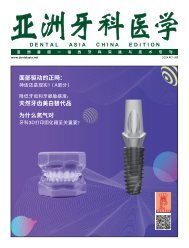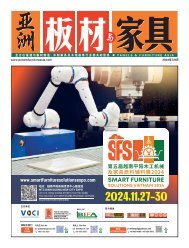Dental Asia March/April 2019
For more than two decades, Dental Asia is the premium journal in linking dental innovators and manufacturers to its rightful audience. We devote ourselves in showcasing the latest dental technology and share evidence-based clinical philosophies to serve as an educational platform to dental professionals. Our combined portfolio of print and digital media also allows us to reach a wider market and secure our position as the leading dental media in the Asia Pacific region while facilitating global interactions among our readers.
For more than two decades, Dental Asia is the premium journal in linking dental innovators
and manufacturers to its rightful audience. We devote ourselves in showcasing the latest dental technology and share evidence-based clinical philosophies to serve as an educational platform to dental professionals. Our combined portfolio of print and digital media also allows us to reach a wider market and secure our position as the leading dental media in the Asia Pacific region while facilitating global interactions among our readers.
Create successful ePaper yourself
Turn your PDF publications into a flip-book with our unique Google optimized e-Paper software.
Clinical Feature<br />
1. Decay is noted on the distal surface<br />
of the right mandibular 2 nd bicuspid<br />
(Fig. 2).<br />
2. The decay is accessed and removed<br />
with the Great White #2 bur (SSWhite)<br />
(Fig. 3).<br />
3. The conservative cavity preparation<br />
is complete. The tooth is matrixed<br />
and subsequently wedged (Fig. 4).<br />
4. The preparation is bonded with a 7 th<br />
generation adhesive (Fig. 5).<br />
5. The bonding agent is light-cured with<br />
the Fusion 5 (Dentlight) (Fig. 6).<br />
6. The cavity is restored with composite<br />
resin as the interproximal contact is<br />
made with the CCI (Contact Curing<br />
Instrument, Hu-Friedy) (Fig. 7).<br />
7. The occlusal surface is pre-shaped<br />
with the “Duckhead” instrument<br />
(Hu-Friedy) prior to curing of the<br />
surface layer (Fig. 8).<br />
8. Final surface polishing (Fig. 9).<br />
9. The completed restoration<br />
(Fig. 10). DA<br />
Fig. 2<br />
Fig. 4<br />
Fig. 3<br />
Fig. 5<br />
References:<br />
1. Harris RK, Phillips RW, Swartz ML. An evaluation<br />
of two resin systems for restoration of abraded<br />
areas. J Prosthet Dent 1974;31:537-546<br />
2. Albers HF. Dentin-resin bonding. Adept Report<br />
1990;1:33-34.<br />
3. Munksgaard EC, Asmussen E. Dentin-polymer<br />
bond promoted by Gluma and various resins. J<br />
Dent Res 1985;64:1409-1411.<br />
4. Causlon BE, Improved bonding of composite<br />
resin to dentin. Br Dent J 1984;156:93.<br />
5. Joynt RB, Davis, EL Weiczkowski G, Yu XY. Dentin<br />
bonding agents and the smear layer. Oper Dent<br />
1991;16:186-191.<br />
6. Lambrechts P, Braem M, Vanherle G. Evaluation<br />
of clinical performance for posterior composite<br />
resins and dentin adhesives. Oper Dent<br />
1987;12:53-78.<br />
7. Christensen GJ. Bonding ceramic or metal<br />
crowns with resin cement. Clin Res Associatees<br />
Newsletter 1992;16:1-2.<br />
8. O’Keefe K, Powers JM. Light-cured resin cements<br />
for cementation of esthetic restorations. J Esthet<br />
Dent 1990;2:129-131.<br />
9. Barkmeier WW, Latta MA. Bond strength of Dicor<br />
using adhesive systems and resin cement. J Dent<br />
Res 1991;70:525. Abstract.<br />
10. Holtan JR, Nyatrom GP, Renasch SE, Phelps<br />
RA, Douglas WH. Microleakage of five dentinal<br />
adhesives. Op Dent 1993;19:189-193.<br />
11. Fortin D, PerdigaoJ, Swift EJ. Microleakage<br />
of three new dentin adhesives. An J Dent<br />
1994;7:217-219.<br />
Fig. 6<br />
Fig. 8<br />
Fig. 10<br />
Fig. 7<br />
Fig. 9<br />
46<br />
DENTAL ASIA MARCH / APRIL <strong>2019</strong>


















